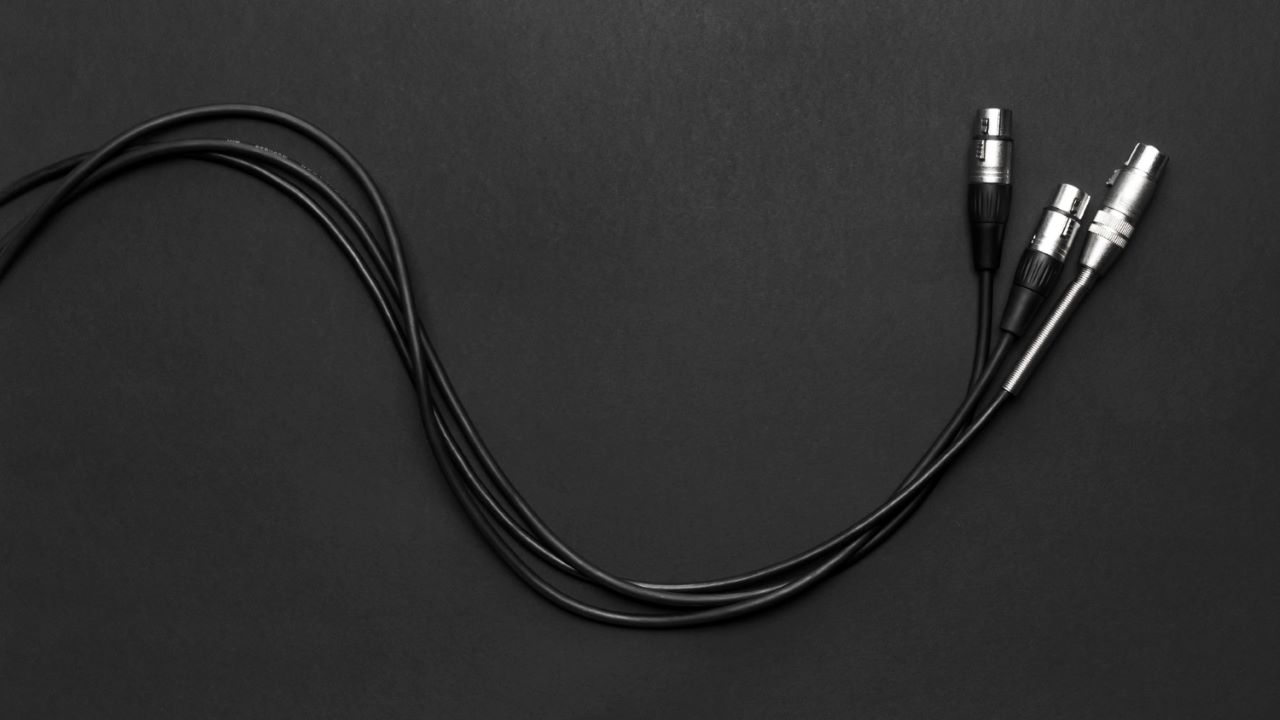In the world of audio technology, connections and cables play a pivotal role in defining the quality of sound for podcast recording. Among these, XLR connections stand out for their reliability and widespread use in professional audio equipment. However, not all XLR connections are designed equal. In this article, we delve into the lesser-discussed realm of unbalanced XLR connections, unraveling their mysteries and practical applications.
So, if you’re a budding audio enthusiast, podcast expert or a seasoned sound engineer, understanding the nuances of unbalanced XLR connections can significantly impact your audio setup and performance.
Related: Podcast Starter Kit
Contents
Defining Unbalanced XLR
Unbalanced XLR connections, often overshadowed by their balanced counterparts, hold a unique place in audio transmission. To understand them, we must first differentiate between balanced and unbalanced connections. An unbalanced XLR connection typically uses two wires: one carries the signal and the other serves as a ground.
This simplicity, however, comes with a susceptibility to noise and interference, especially over longer distances. Unbalanced XLRs are commonly found in consumer audio equipment and some professional scenarios where short cable runs are involved. Their design, while seemingly straightforward, has specific implications for sound quality and system setup.
Technical Aspects Of Unbalanced XLR

Image by Freepik
When we talk about the technical aspects of unbalanced XLR connections, we’re venturing into the heart of audio engineering. This section aims to demystify the inner workings of unbalanced XLRs, shedding light on their construction, functionality, and implications for audio quality.
While they might seem less complex than their balanced counterparts, understanding the intricacies of unbalanced XLR connections is crucial for anyone dealing with audio systems, be it in a home studio, a live performance, or a professional recording environment.
Pin Configuration
The pin configuration in an unbalanced XLR connector is a critical aspect that dictates its functionality. As mentioned earlier, a standard XLR connector comprises three pins. In an unbalanced setup, the key lies in how these pins are utilized.
Typically, Pin 1 is connected to the ground, serving as the anchor for the entire connection. Pin 2, often referred to as the ‘hot’ wire, carries the audio signal. Pin 3, which in a balanced connection would carry an inverted copy of the audio signal, is either left disconnected or tied to the ground in unbalanced configurations.
This configuration has significant implications. By tying Pin 3 to the ground, the connector essentially becomes a two-wire system – one for signal and one for ground. This setup simplifies the connection but at the cost of reduced noise immunity. The grounding technique, while providing a basic shield against interference, is not as effective as the noise-canceling capabilities seen in balanced connections.
For audio professionals, understanding this configuration is crucial for both setting up systems and troubleshooting audio issues.
Signal Transmission Process
The signal transmission process in unbalanced XLR connections is both straightforward and nuanced. In these connections, the audio signal travels along the ‘hot’ wire (Pin 2), with the ground wire providing a reference and minimal shielding. This simplicity, however, comes with its challenges.
The single signal wire is more susceptible to electromagnetic interference (EMI) and radio-frequency interference (RFI), which can be picked up from various sources like wireless devices, power cables, and other electronic equipment.
The impact of this interference is more pronounced over longer cable runs. As the distance increases, the likelihood of noise infiltration grows, potentially leading to a noticeable degradation in sound quality. This is why unbalanced XLR connections are typically recommended for shorter distances, where the risk of interference is lower.
For audio technicians and enthusiasts, understanding the limitations and appropriate applications of unbalanced XLR connections is essential for maintaining sound integrity in various setups.
Practical Applications And Limitations

Image by user5812043 on Freepik
Exploring the practical applications and limitations of unbalanced XLR connections is crucial for anyone involved in audio work, from home theater enthusiasts to professional sound engineers. While these connections have their place in various audio setups, understanding where and how to use them effectively is key to achieving the best sound quality.
Audio Equipment In Home Theaters
In home theaters, unbalanced XLR connections find their niche in connecting various audio components like AV receivers, speakers, and subwoofers. The primary advantage here is the simplicity and affordability of these connections. Most consumer audio equipment is designed with unbalanced inputs and outputs, making unbalanced XLRs a compatible choice.
However, the technicalities of using unbalanced XLRs in home theaters require careful consideration. The shorter XLR cable runs typically in home environments help mitigate the risk of noise interference, which is a significant advantage. Yet, it’s crucial to ensure that the cable quality is high and the connections are secure to minimize potential noise issues.
Additionally, when setting up subwoofers or surround sound systems, the alignment of the unbalanced connections must be precise to avoid any phase cancellation or sound quality degradation. This precision is vital for achieving the immersive audio experience that home theaters strive for.
Professional Audio Setups
In professional audio setups, such as recording studios or live sound environments, unbalanced XLR connections are less common but still have specific uses. They are often employed in connecting certain types of microphones, direct boxes, and some audio interfaces where balanced connections are not a necessity. The key in these settings is understanding the limitations of unbalanced XLRs and using them strategically.
The technical considerations in professional settings are more stringent. For instance, when unbalanced XLRs are used in studio environments, it’s typically for short patch cables connecting gear within close proximity. The professionals must be vigilant about the potential for noise and interference, especially in environments with a high density of electronic equipment.
Moreover, impedance matching becomes crucial in these setups. Mismatched impedance can lead to signal loss and degradation, which is unacceptable in a professional context. Therefore, while unbalanced XLRs can be used in professional setups, their application requires careful planning and understanding of the technical landscape.
Portable Audio Devices

Image by DCStudio on Freepik
Portable audio devices, such as field recorders, portable interfaces, and camera audio inputs, often utilize unbalanced XLR connections due to their compactness and ease of use. In these scenarios, the priority is on portability and convenience rather than long-distance signal transmission. The technical aspect to consider here is the robustness of the connection in mobile environments.
The connectors must be secure and resistant to movement-related disconnections or noise. Additionally, the shielding of the cables becomes crucial to protect against the diverse range of interference sources one might encounter in the field.
Consumer Audio Interfaces
Consumer audio interfaces, particularly those used in home recording setups, frequently feature unbalanced XLR connections. These interfaces cater to amateur musicians and podcasters who require a simple, cost-effective solution for connecting microphones and instruments. The technical focus of this application is on ensuring compatibility with a wide range of consumer-grade equipment.
Users must be aware of the potential noise issues and the importance of keeping unbalanced/balanced cable runs short. Additionally, understanding the gain staging and input/output levels is vital to prevent signal clipping or degradation, ensuring a clean and clear recording.
Limitations And Challenges
While unbalanced XLR connections offer certain advantages, they also come with inherent limitations and challenges that can impact audio quality and system performance. Let’s explore the most significant of these challenges, providing insights into how they can affect audio setups and what can be done to mitigate their impact.
Susceptibility To Interference
One of the primary challenges with unbalanced XLR connections is their susceptibility to electromagnetic and radio-frequency interference. This vulnerability arises from the single-wire signal transmission, which lacks the noise-canceling properties of balanced connections.
In environments with high levels of EMI or RFI, such as near radio transmitters, power lines, or heavy electronic equipment, unbalanced XLRs can pick up unwanted noise. This interference manifests as a hum, buzz, or radio signal intrusion in the audio output.
The technical approach to mitigating this issue involves several strategies. First, using high-quality cables with robust shielding can help reduce the impact of external interference. Additionally, keeping cable runs as short as possible and avoiding running them parallel to power cables or other potential sources of interference is crucial.
In situations where interference is unavoidable, it may be necessary to switch to balanced connections or use isolation transformers to protect the audio signal.
Distance Limitations

Image by Racool_studio on Freepik
Distance limitations are another significant challenge associated with unbalanced XLR connections. Due to their increased susceptibility to noise and signal degradation over longer distances, unbalanced XLR cables are generally not recommended for runs exceeding 15 to 20 feet (approximately 4.5 to 6 meters). Beyond this range, the risk of noise infiltration and signal loss becomes significantly higher, which can severely impact audio quality.
In technical terms, the longer the cable, the greater the capacitance, which can lead to high-frequency roll-off and a dulling of the sound. For applications requiring longer cable runs, it’s often advisable to use balanced connections, which can handle longer distances without significant loss of audio quality.
For those committed to using unbalanced connections, meticulous cable management and the use of high-quality, low-capacitance cables can help mitigate some of these issues, though they cannot entirely eliminate the distance limitation.
Comparing Unbalanced XLR To Other Connectors
In the diverse world of audio connectors, each type serves a unique purpose and comes with its own set of characteristics. Understanding how unbalanced XLR connectors compare to other common types, such as balanced XLR, RCA, and TRS, is crucial for anyone involved in audio work.
This comparison not only highlights the differences in design and functionality but also sheds light on the appropriate applications and limitations of each connector type. Let’s dive into a detailed comparison, focusing on the technical nuances that distinguish these connectors from one another.
Unbalanced XLR Vs. Balanced XLR
When comparing unbalanced XLR to balanced XLR connectors, the primary distinction lies in their signal-carrying method and noise rejection capabilities. An unbalanced XLR connector transmits the audio signal via a single wire, with another serving as the ground. This configuration, while simpler, is less effective at rejecting noise and interference, making it suitable for shorter cable runs and environments with minimal electromagnetic interference.
On the other hand, a balanced XLR connector uses a three-wire system – two for carrying the audio signal (hot and cold) and one for ground. The cold wire carries an inverted version of the audio signal, allowing for superior noise rejection. This design enables the noise picked up along the cable to be effectively canceled out at the destination, making balanced XLRs ideal for professional audio applications, especially where long cable runs and high-quality audio are required.
Despite their physical similarities, unbalanced and balanced XLR connectors differ significantly in how their pins are wired and utilized. The cost and complexity also vary; unbalanced XLRs are generally simpler and more cost-effective, whereas balanced XLRs, due to their additional wiring, offer better performance but are more complex and slightly more expensive.
This makes balanced XLRs a preferred choice in professional settings where audio quality and cable length are critical factors.
Unbalanced XLR Vs. RCA And TRS
The comparison between unbalanced XLR connectors and RCA and TRS connectors highlights differences in design, usage, and signal transmission. Unbalanced XLR connectors are typically used in professional audio equipment and feature a three-pin design, often with a locking mechanism for secure connections. RCA connectors, common in consumer audio and video equipment, have a single-pin design with a shielding outer ring.
TRS connectors, which can be found in both professional and consumer audio, have a three-contact point design (tip, ring, sleeve) and come in various sizes, with 1/4 inch being the most common.
In terms of signal transmission, unbalanced XLR and RCA connectors share a similarity in being more susceptible to noise over long distances. This is due to their single-wire signal transmission method. TRS connectors, however, offer more versatility. They can carry both balanced and unbalanced signals, with balanced TRS cables providing better noise rejection, similar to balanced XLR connectors.
The application suitability of these connectors also varies. Unbalanced XLR connectors are suitable for professional audio settings with short cable runs, while RCA connectors are ideal for home audio and video systems. TRS connectors, due to their versatility, are used in a wide range of applications, from professional (balanced) to consumer (unbalanced) audio setups.
In terms of interference and sound quality, both unbalanced XLR and RCA connectors are more prone to interference over long distances, whereas TRS connectors, when used in a balanced configuration, offer better interference rejection, comparable to balanced XLR connectors.
The Future Of Unbalanced XLR
As we look toward the future of unbalanced XLR connections, it’s essential to consider the current trends, technological advancements, and shifts in industry adoption. While these connectors have been a staple in the audio world for many years, the rapid evolution of technology and the changing demands of the industry pose new challenges and opportunities.
Let’s dive into how unbalanced XLR connections are adapting to these changes and what their role might be in the future landscape of audio technology.
Current Trends And Innovations
The audio industry is currently witnessing a blend of traditional practices and innovative approaches, and unbalanced XLR connections are at the crossroads of this evolution. One of the significant trends is the increasing demand for higher audio quality in consumer products.
This shift is leading to the adoption of technologies that were once reserved for professional settings. However, unbalanced XLR connections, due to their inherent limitations in noise rejection and distance capabilities, face challenges in meeting these higher standards.
Innovations in cable and connector technology are also impacting the use of unbalanced XLRs. Advances in shielding materials and connector design are helping to mitigate some of the traditional weaknesses of unbalanced connections, such as susceptibility to interference.
These improvements are extending the practicality of unbalanced XLR connections in more diverse environments, albeit still within the constraints of shorter cable runs.
Technological Advancements

Image by serhii_bobyk on Freepik
Technological advancements in the broader field of audio and electronics are influencing the role of unbalanced XLR connections. The development of more sophisticated and compact digital audio equipment is one such advancement. As devices become smaller and more integrated, the need for simpler and less bulky connectors like unbalanced XLRs may diminish.
Additionally, the rise of wireless technology is revolutionizing how audio signals are transmitted, potentially reducing the reliance on traditional wired connections. While unbalanced XLRs will likely maintain their relevance in specific applications, the growing capabilities of wireless and digital technologies could limit their use in future audio systems.
Industry Adoption And Shifts
The audio industry is continuously evolving, with shifts in both consumer preferences and professional practices. In professional environments, there’s a noticeable trend towards balanced connections due to their superior audio quality and reliability. This shift is partly driven by the increasing affordability of high-quality, balanced equipment, making it more accessible to a broader range of users.
In the consumer market, the trend is towards more user-friendly and versatile connections, such as USB and HDMI, which can carry multiple types of signals. While unbalanced XLR connections are unlikely to disappear entirely, their role may become more niche, catering to specific applications where their unique attributes are most beneficial.
Predicting The Future
Predicting the future of audio technology, and specifically the role of unbalanced XLR connections, involves considering the impact of digital technology and the potential for these connectors to be phased out. As the industry continues to innovate and evolve, these factors will play a crucial role in shaping the landscape of audio connections.
The Role Of Digital Technology
Digital technology is at the forefront of transforming the audio industry. The shift towards digital audio interfaces and protocols is changing the way audio is captured, processed, and transmitted. This digital revolution offers higher fidelity, greater flexibility, and the potential for integrating advanced features like signal processing and network connectivity.
The impact of this shift on unbalanced XLR connections is significant. As digital interfaces become more prevalent, the need for traditional analog connections, including unbalanced XLRs, may decrease. However, there will likely remain scenarios where the simplicity and familiarity of unbalanced XLR connections are preferred, particularly in settings where digital technology’s added complexity and cost are not justified.
Potential Phasing Out Of Unbalanced XLR

Image by DCStudio on Freepik
The potential phasing out of unbalanced XLR connections is a topic of much debate in the audio community. While it’s unlikely that these connectors will become obsolete in the near future, their role is expected to diminish as newer technologies gain prominence.
The trend towards digital and wireless solutions, along with the increasing preference for balanced connections even in consumer-level equipment, suggests a narrowing scope for unbalanced XLRs.
However, the complete phasing out of unbalanced XLR connections is not imminent. They are likely to persist in certain applications where their specific advantages, such as ease of use and cost-effectiveness, align with the requirements of the project or environment.
The future of unbalanced XLR connections will be shaped by a balance between traditional audio practices and the ongoing technological evolution in the industry.
FAQs
When Should I Use Unbalanced Cables?
Unbalanced cables are best used in situations where you have short cable runs and a low likelihood of electromagnetic interference (EMI). This typically includes environments like home studios, small audio setups, or connections between consumer audio devices.
The technical reason behind this is that unbalanced cables are more susceptible to noise and interference over longer distances. They consist of a single signal wire and a ground wire, which makes them less capable of rejecting noise compared to balanced cables.
In practical terms, unbalanced cables are suitable for:
- Connect devices that are close together (typically less than 15-20 feet or 4.5-6 meters).
- Environments with minimal electrical interference, such as home theaters or desktop computer setups.
- Consumer audio equipment, like connecting a CD player, turntable, or media player to an amplifier or receiver.
What Happens If You Use An Unbalanced Cable In A Balanced Output?

Image by Freepik
Using an unbalanced cable in a balanced output can lead to several issues, primarily related to noise and potential signal degradation. Balanced outputs are designed to send two versions of the audio signal: one normal and one inverted. When these signals reach the destination, the inverted signal is flipped and combined with the normal signal, which cancels out any noise picked up along the way.
When you connect an unbalanced cable to a balanced output:
- The noise-canceling feature of the balanced output is lost. Any noise picked up by the cable will not be canceled out and can be audible in the final output.
- There might be a reduction in the overall signal level, as the balanced output expects two signals to combine, but only one is effectively being used.
- In some cases, depending on the equipment, this mismatch can lead to technical issues or suboptimal performance, although it generally won’t cause damage to the equipment.
Is 4-pin XLR Always Balanced?
A 4-pin XLR connector is not always used for balanced signals. The 4-pin XLR configuration is versatile and can be used for various purposes, including balanced audio, but it’s also commonly used for other applications. For example, 4-pin XLR connectors are frequently used in professional video cameras for power connections, in intercom headsets for two-way communication, and in some lighting equipment for balanced signal.
In the context of audio, a 4-pin XLR could be used for balanced stereo audio (two pins for each channel) or other specialized audio applications. However, it’s essential to check the specific equipment’s documentation or technical specifications to understand how the 4-pin XLR is being used in that particular context.
How Do I Convert Unbalanced Audio To Balanced?
Converting unbalanced audio to balanced audio typically involves using a device known as a Direct Injection (DI) box or a balun (balance-unbalance transformer). These devices are designed to take the unbalanced signal and convert it into a balanced one, which can then be transmitted over longer distances with less susceptibility to noise and interference.
The technical process involves:
- Connecting the unbalanced source (such as a guitar or a keyboard) to the input of the DI box.
- The DI box internally converts the unbalanced signal into a balanced one, often with the help of transformers or active circuitry.
- The balanced output from the DI box can then be connected to a balanced input, like a mixer or audio interface, using balanced cables (typically XLR or TRS).
DI boxes come in various forms, including passive (which use transformers) and active (which require power and use electronic circuitry). The choice between passive and active DI boxes depends on the specific requirements of the audio source and the desired sound characteristics.
Final Words
In summary, this article has explored the intricate world of unbalanced XLR connections, shedding light on their technical aspects, practical applications, and limitations. We’ve delved into the specifics of pin configuration and signal transmission, highlighting the scenarios where unbalanced XLRs are most effective and their inherent challenges.
The comparison with balanced XLR, RCA, and TRS connectors provided insights into choosing the right connector for different audio setups. Looking ahead, we discussed the evolving trends, technological advancements, and the potential future of unbalanced XLRs in an increasingly digital and wireless world.
Whether you’re a professional sound engineer or an audio enthusiast, understanding these aspects of unbalanced XLR connections is crucial for navigating the complex landscape of audio technology.
